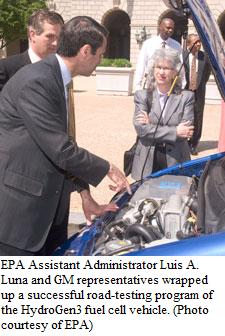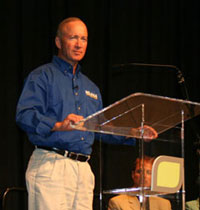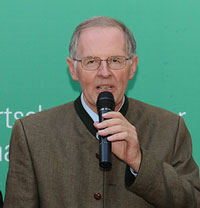 The U.S. Environmental Protection Agency is practicing what it preaches as the agency in charge of keeping America clean is testing a hydrogen fuel cell car that is part of its green fleet of vehicles.
The U.S. Environmental Protection Agency is practicing what it preaches as the agency in charge of keeping America clean is testing a hydrogen fuel cell car that is part of its green fleet of vehicles.
This press release from the EPA says the Chevy Equinox Fuel Cell Car is the latest in American technology:
“EPA is turning the key on an engine of change, by turning fleet emissions from CO2 to H2O,” said EPA Administrator Stephen L. Johnson. “EPA supports new technologies such as hydrogen fuel cells that are good for our environment and good for our economy.”
 The vehicle, the forth generation Chevrolet Equinox Fuel Cell, is an electric car enabled by General Motors’ advanced fuel cell propulsion system and is tested and engineered for 50,000 miles of driving life. With hydrogen as its only fuel, this vehicle emits no greenhouse gases and serves as an alternative to traditional, petroleum-dependent vehicles that emit carbon dioxide, nitrous oxide, and other air pollutants. Featuring the latest advancements in fuel cell technology, the vehicle can travel up to 150 miles per fill-up, and is expected to meet all applicable 2008 federal motor vehicle safety standards.
The vehicle, the forth generation Chevrolet Equinox Fuel Cell, is an electric car enabled by General Motors’ advanced fuel cell propulsion system and is tested and engineered for 50,000 miles of driving life. With hydrogen as its only fuel, this vehicle emits no greenhouse gases and serves as an alternative to traditional, petroleum-dependent vehicles that emit carbon dioxide, nitrous oxide, and other air pollutants. Featuring the latest advancements in fuel cell technology, the vehicle can travel up to 150 miles per fill-up, and is expected to meet all applicable 2008 federal motor vehicle safety standards.
The project has been made possible through cooperation with the U.S. Department of Energy in the form of a grant from the DOE to pay for a six-month lease on the vehicle.


 Wal-Mart Foundation recently donated $369,000 to the Arkansas Biosciences Institute at Arkansas State University to help fund biomass to ethanol research.
Wal-Mart Foundation recently donated $369,000 to the Arkansas Biosciences Institute at Arkansas State University to help fund biomass to ethanol research.
 The latest crop production forecast out Friday from the U.S. Department of Agriculture slightly lowered the
The latest crop production forecast out Friday from the U.S. Department of Agriculture slightly lowered the 
 Ethanol-powered planes flew in formation in the blue Hoosier sky Thursday to mark the opening of Indiana’s newest ethanol plant in North Manchester.
Ethanol-powered planes flew in formation in the blue Hoosier sky Thursday to mark the opening of Indiana’s newest ethanol plant in North Manchester. “With its third Indiana facility, POET is quickly becoming a household name in our small towns,” said Indiana Governor Mitch Daniels. “This new North Manchester facility means more good jobs and an important market for our Hoosier farmers.”
“With its third Indiana facility, POET is quickly becoming a household name in our small towns,” said Indiana Governor Mitch Daniels. “This new North Manchester facility means more good jobs and an important market for our Hoosier farmers.”  The group of 250
The group of 250  The president of the Austrian Chamber of Forestry and Agriculture Gerhard Wlodkowski commented on the issue during his welcome address to the journalists. He noted that consumers in Austria are complaining about the increase in food prices, but they “don’t consider that in the year 1970 in Austria everybody spent 33 percent of their income for food and today they spend only 13 percent of their income.”
The president of the Austrian Chamber of Forestry and Agriculture Gerhard Wlodkowski commented on the issue during his welcome address to the journalists. He noted that consumers in Austria are complaining about the increase in food prices, but they “don’t consider that in the year 1970 in Austria everybody spent 33 percent of their income for food and today they spend only 13 percent of their income.”  “We have clearly seen a positive impact since the biodiesel tax incentive was enacted as part of the American Jobs Creation Act of 2004,” Feraci stated. “Not only has there been an increase in jobs, biodiesel has proven to be a viable energy alternative which is environmentally friendly. Continuing this incentive will take the nation one large step closer to energy independence,” Feraci continued.
“We have clearly seen a positive impact since the biodiesel tax incentive was enacted as part of the American Jobs Creation Act of 2004,” Feraci stated. “Not only has there been an increase in jobs, biodiesel has proven to be a viable energy alternative which is environmentally friendly. Continuing this incentive will take the nation one large step closer to energy independence,” Feraci continued. Earlier this week at the new, green NBB building grand opening ceremony in Jefferson City, Mo., Missouri Congressman Kenny Hulshof made the case why the biodiesel industries needs the incentives. He explained that it’s the only way to level the playing field with the petroleum industry that has been the benefactor of tax breaks for decades… even as it enjoyed record profits.
Earlier this week at the new, green NBB building grand opening ceremony in Jefferson City, Mo., Missouri Congressman Kenny Hulshof made the case why the biodiesel industries needs the incentives. He explained that it’s the only way to level the playing field with the petroleum industry that has been the benefactor of tax breaks for decades… even as it enjoyed record profits. A handful of students at Washington State University are trying to take their energy future into their own hands. While the WSU Biodiesel Club only got about 10 members at their first meeting this week, organizers hope that the student-run operation soon will be producing 200 gallons of the green fuel a day.
A handful of students at Washington State University are trying to take their energy future into their own hands. While the WSU Biodiesel Club only got about 10 members at their first meeting this week, organizers hope that the student-run operation soon will be producing 200 gallons of the green fuel a day.  During this week’s ribbon-cutting ceremony at the new National Biodiesel Board building in Jefferson City, those in attendance included local and state officials and nine members of the Board from around the country.
During this week’s ribbon-cutting ceremony at the new National Biodiesel Board building in Jefferson City, those in attendance included local and state officials and nine members of the Board from around the country.